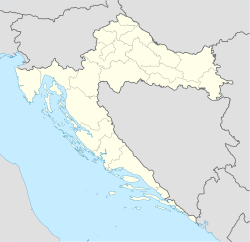Krapina
Krapina | |
|---|---|
| Grad Krapina Town of Krapina | |
|
Top: View on Krapina; Bottom: Town center | |
 | |
| Coordinates: 46°10′N 15°52′E / 46.16°N 15.87°E | |
| Country | |
| County | |
| Government | |
| • Mayor | Zoran Gregurović (HDZ) |
| • City Council | 17 members |
| Area | |
• Town | 47.7 km2 (18.4 sq mi) |
| • Urban | 2.5 km2 (1.0 sq mi) |
| Elevation | 203 m (666 ft) |
| Population (2021)[2] | |
• Town | 11,530 |
| • Density | 240/km2 (630/sq mi) |
| • Urban | 4,201 |
| • Urban density | 1,700/km2 (4,400/sq mi) |
| Time zone | UTC+1 (Central European Time) |
| Postal code | HR-49 000 |
| Area code | +385 49 |
| Vehicle registration | KR |
| Website | krapina |
Krapina (pronounced [krâpina];[3] Hungarian: Korpona) is a town in northern Croatia and the administrative centre of Krapina-Zagorje County with a population of 4,482 (2011) and a total municipality population of 12,480 (2011).[4] Krapina is located in the hilly Zagorje region of Croatia, approximately 55 km (34 mi) from both Zagreb and Varaždin.
Population
[edit]The following settlements comprise the Krapina municipality:[4]
- Bobovje, population 510
- Doliće, population 436
- Donja Šemnica, population 912
- Gornja Pačetina, population 404
- Krapina, population 4,471
- Lazi Krapinski, population 79
- Lepajci, population 391
- Mihaljekov Jarek, population 469
- Podgora Krapinska, population 565
- Polje Krapinsko, population 666
- Pretkovec, population 66
- Pristava Krapinska, population 214
- Strahinje, population 328
- Straža Krapinska, population 42
- Škarićevo, population 707
- Šušelj Brijeg, population 4
- Tkalci, population 432
- Trški Vrh, population 399
- Velika Ves, population 727
- Vidovec Krapinski, population 215
- Vidovec Petrovski, population 101
- Zagora, population 94
- Žutnica, population 248
| population | 5457 | 6060 | 6435 | 7007 | 7538 | 8141 | 7884 | 8224 | 9222 | 9473 | 10384 | 11533 | 12540 | 12938 | 12950 | 12480 | 11530 |
| 1857 | 1869 | 1880 | 1890 | 1900 | 1910 | 1921 | 1931 | 1948 | 1953 | 1961 | 1971 | 1981 | 1991 | 2001 | 2011 | 2021 |
History
[edit]Krapina has been known since 1193. It has always been a favorite site for castles and country houses of Croatian and Hungarian rulers.
In the first half of the 15th century, it was an important center of the Counts of Celje, who additionally fortified the town and expanded the nearby castle. Later, it came into the possession of the Keglević family.
In the late 19th and early 20th century, Krapina was a district capital in Varaždin County of the Kingdom of Croatia-Slavonia.
Prehistoric site
[edit]In 1899, on a hill called Hušnjakovo near modern Krapina, the archaeologist and paleontologist Dragutin Gorjanović-Kramberger found over 800 fossil remains of Neanderthals.

The half-cave in Krapina was soon listed among the world's science localities as a significant fossil finding site, where the largest and richest collection of the Neanderthal man had ever been found.
At the site where the Neanderthal remains were discovered there is now a state-of-the-art Neanderthal museum which also includes an extensive section on evolution, making it one of the most interesting evolutionary museums in Europe.[6] It is surrounded by a park with many statues of Neanderthals and the game they hunted, a bear, a moose and a beaver set in the actual locations.
Culture
[edit]
Krapina is home to the yearly Festival kajkavske popevke (The festival of kajkavian song) sung in the local Kajkavian language.[7]
There is also a nearby municipality of Krapinske Toplice (Krapina spa) with numerous thermal springs and spa tourist infrastructure. Krapina is also the birthplace of the linguist and language reformer Ljudevit Gaj. His home is now a museum where visitors can learn about his life and work.
Since 1997, Franciscan monastery and St. Catherine's church in Krapina are hosts of the Krapinafest, annual contemporary Christian music festival.[8]
Notable person
[edit]- Mirko Dražen Grmek (1924–2000), Croatian and French historian of medicine, was born in Krapina.
- Ljudevit Gaj (born Ludwig Gay, 1809–1872), was a Croatian linguist, politician, journalist, and writer born in Krapina.
Transportation
[edit]Krapina is served by the A2 freeway and state road D1. It has a train station on the R106 corridor and a bus station which also serves as a hub for the bus company "Presečki d.o.o." - the company connects Krapina with numerous towns across the county and region.[9][10]
See also
[edit]References
[edit]- ^ Register of spatial units of the State Geodetic Administration of the Republic of Croatia. Wikidata Q119585703.
- ^ "Population by Age and Sex, by Settlements" (xlsx). Census of Population, Households and Dwellings in 2021. Zagreb: Croatian Bureau of Statistics. 2022.
- ^ "Krȁpina". Hrvatski jezični portal. Retrieved 25 August 2015.
- ^ a b "Population by Age and Sex, by Settlements, 2011 Census: Krapina". Census of Population, Households and Dwellings 2011. Zagreb: Croatian Bureau of Statistics. December 2012.
- ^ Frayer, David W.; Radovčić, Jakov; Sršen, Ankica Oros; Radovčić, Davorka (11 March 2015). "Evidence for Neandertal Jewelry: Modified White-Tailed Eagle Claws at Krapina". PLOS ONE. 10 (3): e0119802. Bibcode:2015PLoSO..1019802R. doi:10.1371/journal.pone.0119802. ISSN 1932-6203. PMC 4356571. PMID 25760648.
- ^ "Muzej krapinskih neanadertalaca". Mkn.mhz.hr. 2010-02-27. Retrieved 2013-03-26.
- ^ Official Website of Kajkavske popevke
- ^ "Official Website of Krapinafest". Archived from the original on 2021-08-30. Retrieved 2021-08-30.
- ^ "Županijske linije - Autobusne linije - - Putnički promet - Presečki grupa - Putnički promet". www.presecki.hr. Retrieved 2022-06-15.
- ^ "Željeznički kolodvor Krapina". www.radoboj.hr. Retrieved 2022-06-15.



